ACC568 Auditing and Assurance Report: API Audit Risks and Procedures
VerifiedAdded on 2023/03/20
|19
|3694
|56
Report
AI Summary
This report, prepared for the Audit Manager, Wayne Wiadrowski, assesses the audit risks associated with Always Precise Instruments Pty Limited (API). The analysis focuses on material misstatements and errors, examining audit risks arising from ratio analysis, internal control weaknesses related to inventory, and discusses appropriate sampling methods. The report provides a detailed breakdown of audit risks identified through various financial ratios, including current ratio, quick asset ratio, return on equity, return on assets, gross margin, marketing expenses, admin expenses, times interest earned, days in inventory, days in receivables and debt-to-equity ratio, and outlines corresponding audit procedures to mitigate these risks. Furthermore, it highlights weaknesses in API's inventory internal controls, particularly those related to the computerised system and supplier selection, detailing associated audit risks and recommending specific audit procedures. The report emphasizes the importance of thorough testing of internal controls and accounting records to identify and address potential misstatements, ultimately aiming to provide a comprehensive understanding of the audit process and potential risks in API's financial reporting. The report also covers the importance of test of details and control to address the potential misstatements.
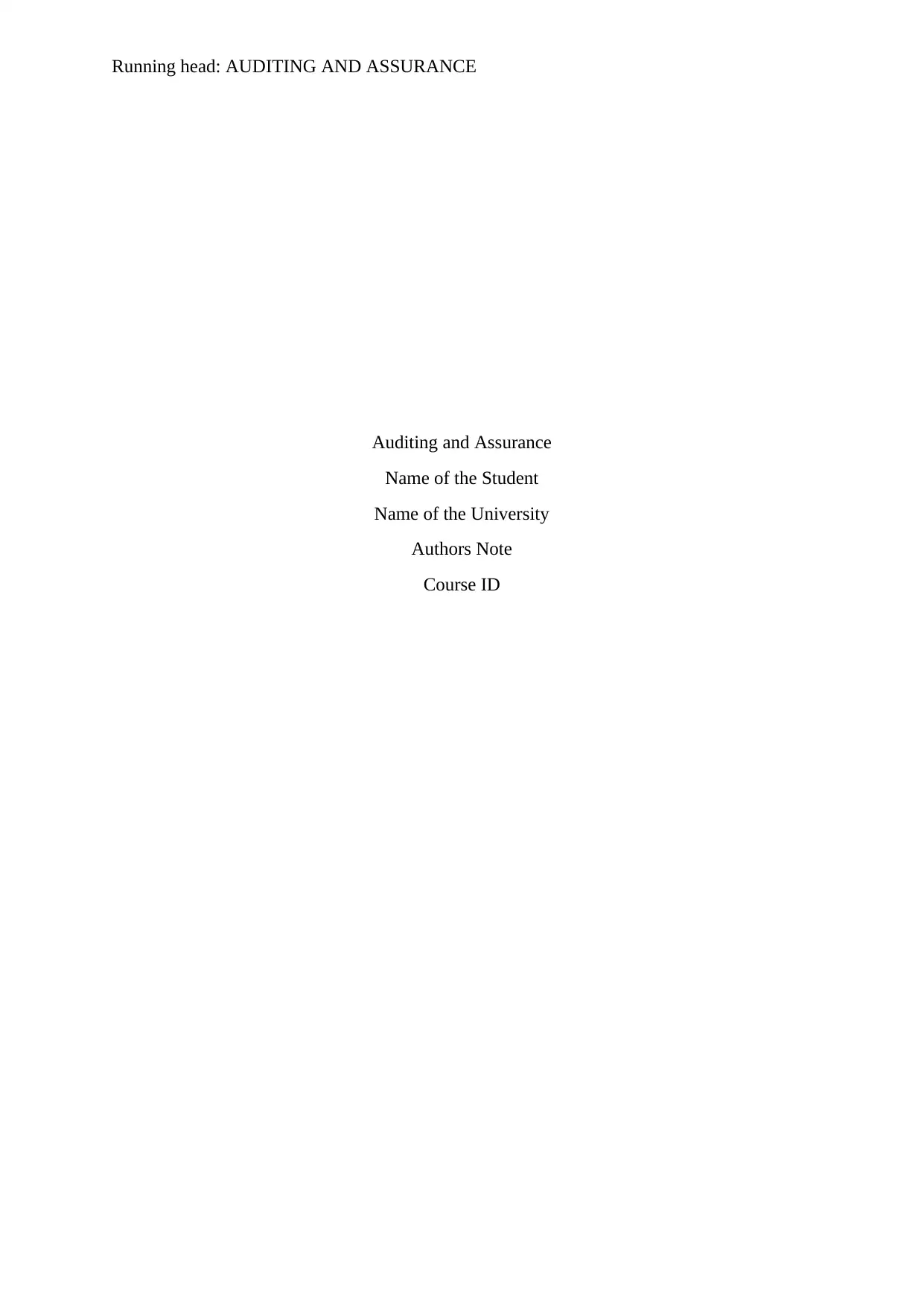
Running head: AUDITING AND ASSURANCE
Auditing and Assurance
Name of the Student
Name of the University
Authors Note
Course ID
Auditing and Assurance
Name of the Student
Name of the University
Authors Note
Course ID
Paraphrase This Document
Need a fresh take? Get an instant paraphrase of this document with our AI Paraphraser
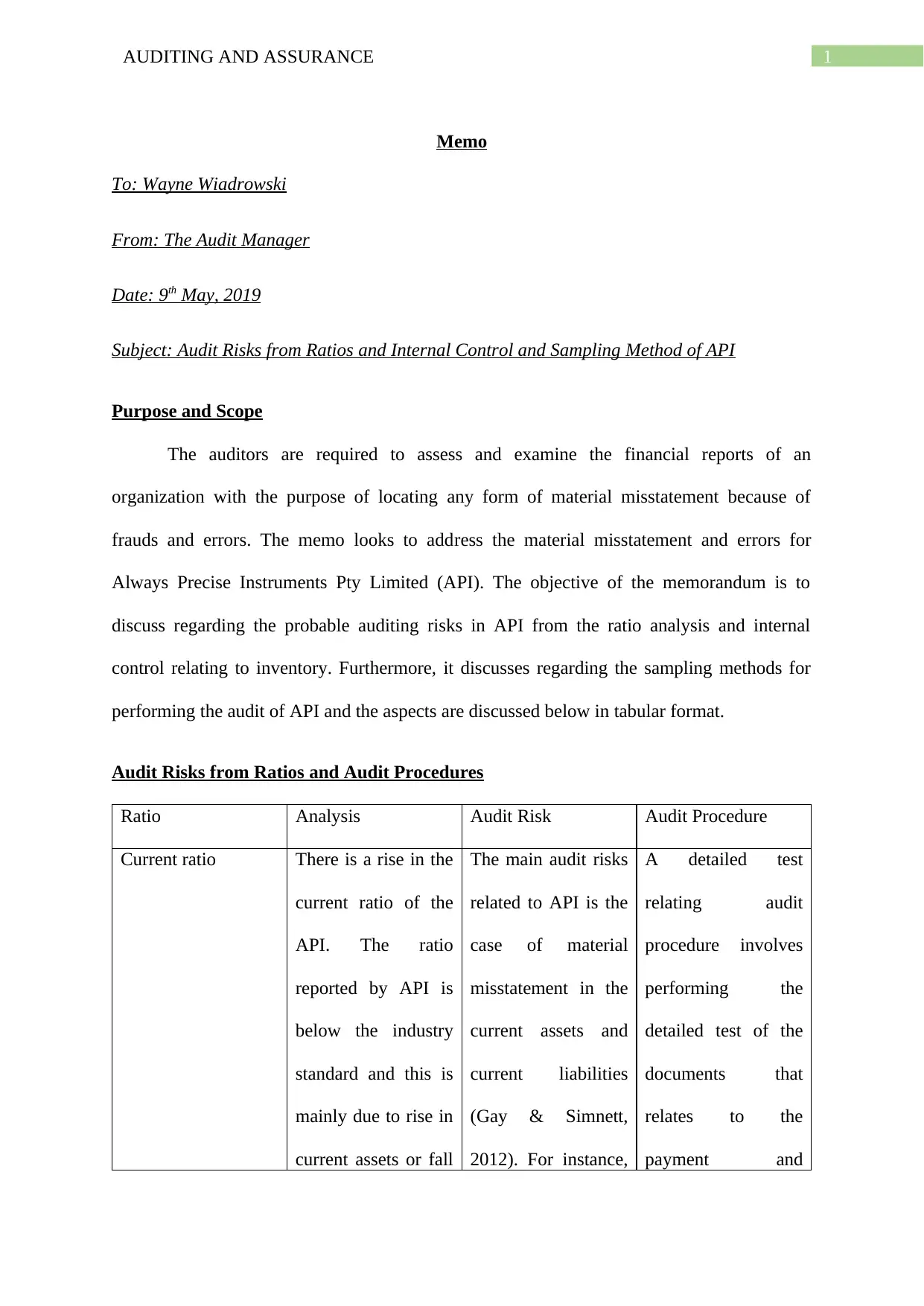
1AUDITING AND ASSURANCE
Memo
To: Wayne Wiadrowski
From: The Audit Manager
Date: 9th May, 2019
Subject: Audit Risks from Ratios and Internal Control and Sampling Method of API
Purpose and Scope
The auditors are required to assess and examine the financial reports of an
organization with the purpose of locating any form of material misstatement because of
frauds and errors. The memo looks to address the material misstatement and errors for
Always Precise Instruments Pty Limited (API). The objective of the memorandum is to
discuss regarding the probable auditing risks in API from the ratio analysis and internal
control relating to inventory. Furthermore, it discusses regarding the sampling methods for
performing the audit of API and the aspects are discussed below in tabular format.
Audit Risks from Ratios and Audit Procedures
Ratio Analysis Audit Risk Audit Procedure
Current ratio There is a rise in the
current ratio of the
API. The ratio
reported by API is
below the industry
standard and this is
mainly due to rise in
current assets or fall
The main audit risks
related to API is the
case of material
misstatement in the
current assets and
current liabilities
(Gay & Simnett,
2012). For instance,
A detailed test
relating audit
procedure involves
performing the
detailed test of the
documents that
relates to the
payment and
Memo
To: Wayne Wiadrowski
From: The Audit Manager
Date: 9th May, 2019
Subject: Audit Risks from Ratios and Internal Control and Sampling Method of API
Purpose and Scope
The auditors are required to assess and examine the financial reports of an
organization with the purpose of locating any form of material misstatement because of
frauds and errors. The memo looks to address the material misstatement and errors for
Always Precise Instruments Pty Limited (API). The objective of the memorandum is to
discuss regarding the probable auditing risks in API from the ratio analysis and internal
control relating to inventory. Furthermore, it discusses regarding the sampling methods for
performing the audit of API and the aspects are discussed below in tabular format.
Audit Risks from Ratios and Audit Procedures
Ratio Analysis Audit Risk Audit Procedure
Current ratio There is a rise in the
current ratio of the
API. The ratio
reported by API is
below the industry
standard and this is
mainly due to rise in
current assets or fall
The main audit risks
related to API is the
case of material
misstatement in the
current assets and
current liabilities
(Gay & Simnett,
2012). For instance,
A detailed test
relating audit
procedure involves
performing the
detailed test of the
documents that
relates to the
payment and
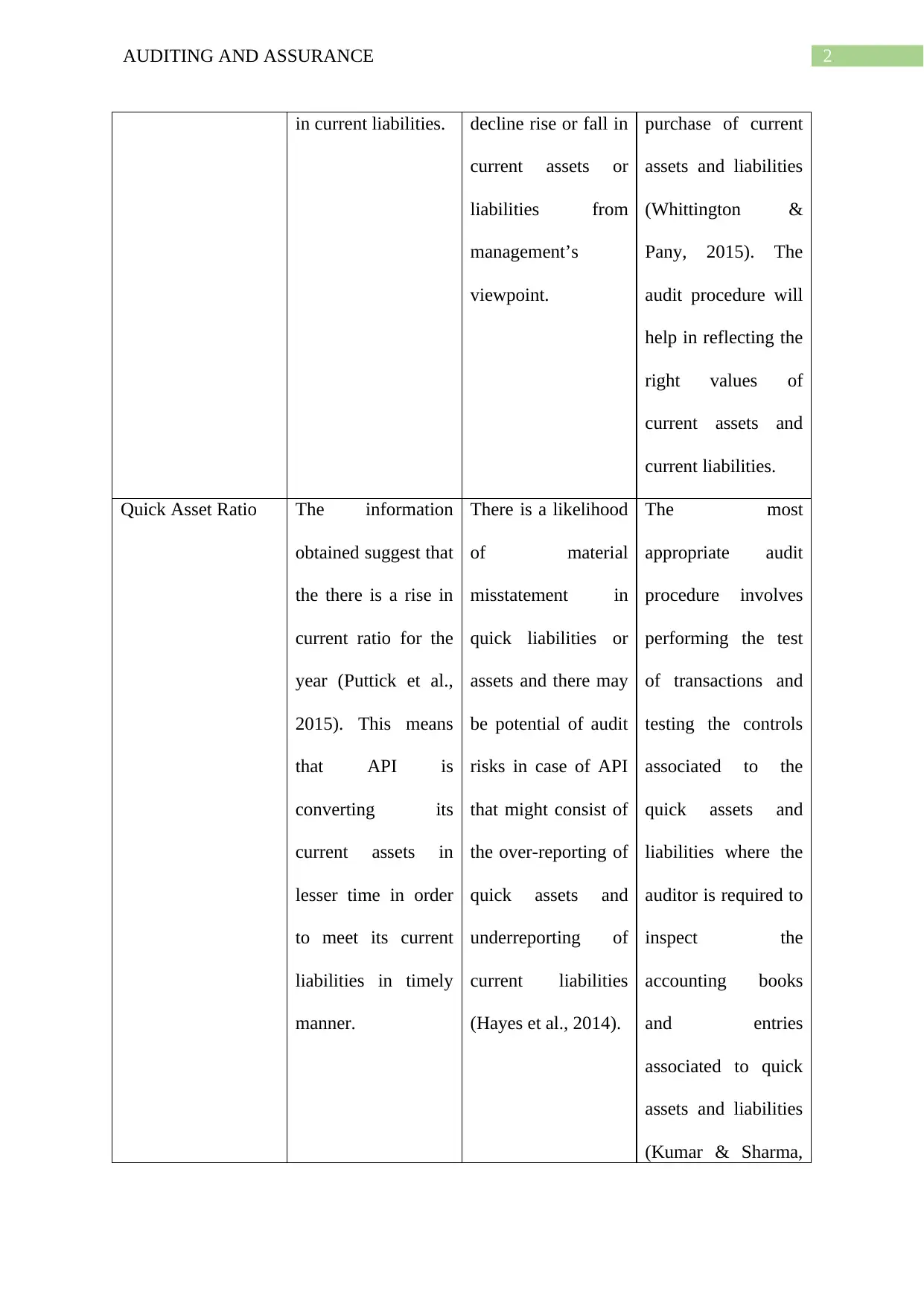
2AUDITING AND ASSURANCE
in current liabilities. decline rise or fall in
current assets or
liabilities from
management’s
viewpoint.
purchase of current
assets and liabilities
(Whittington &
Pany, 2015). The
audit procedure will
help in reflecting the
right values of
current assets and
current liabilities.
Quick Asset Ratio The information
obtained suggest that
the there is a rise in
current ratio for the
year (Puttick et al.,
2015). This means
that API is
converting its
current assets in
lesser time in order
to meet its current
liabilities in timely
manner.
There is a likelihood
of material
misstatement in
quick liabilities or
assets and there may
be potential of audit
risks in case of API
that might consist of
the over-reporting of
quick assets and
underreporting of
current liabilities
(Hayes et al., 2014).
The most
appropriate audit
procedure involves
performing the test
of transactions and
testing the controls
associated to the
quick assets and
liabilities where the
auditor is required to
inspect the
accounting books
and entries
associated to quick
assets and liabilities
(Kumar & Sharma,
in current liabilities. decline rise or fall in
current assets or
liabilities from
management’s
viewpoint.
purchase of current
assets and liabilities
(Whittington &
Pany, 2015). The
audit procedure will
help in reflecting the
right values of
current assets and
current liabilities.
Quick Asset Ratio The information
obtained suggest that
the there is a rise in
current ratio for the
year (Puttick et al.,
2015). This means
that API is
converting its
current assets in
lesser time in order
to meet its current
liabilities in timely
manner.
There is a likelihood
of material
misstatement in
quick liabilities or
assets and there may
be potential of audit
risks in case of API
that might consist of
the over-reporting of
quick assets and
underreporting of
current liabilities
(Hayes et al., 2014).
The most
appropriate audit
procedure involves
performing the test
of transactions and
testing the controls
associated to the
quick assets and
liabilities where the
auditor is required to
inspect the
accounting books
and entries
associated to quick
assets and liabilities
(Kumar & Sharma,
⊘ This is a preview!⊘
Do you want full access?
Subscribe today to unlock all pages.

Trusted by 1+ million students worldwide

3AUDITING AND ASSURANCE
2015). This will help
the auditor to
recognize the
misstatement in
quick assets and
liabilities.
Return on Equity The ratio represents
a fall in value for
2018 and the ratio in
API appears below
the industry standard
(Louwers et al.,
2015). There may be
a probability of rise
in equity capital of
the company or
decline in net profit.
The existence of
misstatement in
equity capital
possess probable
risks for API which
contributes towards
fall and rise in the
ratio (Cook et al.,
2016). The debt
amount can be
lowered by
misstatement of
equity capital.
The auditor is
responsible for
performing test of
audit procedure
adopted by the
company and also
involves inspecting
the account books,
records and
transactions that is
associated to equity
share capital for
identifying the
misstatement. This
will help in reducing
the probable risk
(Zeff, 2016).
Return on Total
Assets
The ratio reflects a
fall in value for API
Material
misstatement in the
Audit test relating to
major audit details
2015). This will help
the auditor to
recognize the
misstatement in
quick assets and
liabilities.
Return on Equity The ratio represents
a fall in value for
2018 and the ratio in
API appears below
the industry standard
(Louwers et al.,
2015). There may be
a probability of rise
in equity capital of
the company or
decline in net profit.
The existence of
misstatement in
equity capital
possess probable
risks for API which
contributes towards
fall and rise in the
ratio (Cook et al.,
2016). The debt
amount can be
lowered by
misstatement of
equity capital.
The auditor is
responsible for
performing test of
audit procedure
adopted by the
company and also
involves inspecting
the account books,
records and
transactions that is
associated to equity
share capital for
identifying the
misstatement. This
will help in reducing
the probable risk
(Zeff, 2016).
Return on Total
Assets
The ratio reflects a
fall in value for API
Material
misstatement in the
Audit test relating to
major audit details
Paraphrase This Document
Need a fresh take? Get an instant paraphrase of this document with our AI Paraphraser

4AUDITING AND ASSURANCE
for 2018 which
implies that the
company has been
failure in effectively
using its assets for
the present year with
the intention of
making profit.
accounting balances
of API is regarded as
the potential audit
risks under this
situation because of
the fact that there is
a fall in the ratio
values and
significantly affect
the profits of the
company (William
et al., 2016).
should be performed
by the auditor in
circumstances where
the account balances
and accounting
transaction of the
company’s asset
appear misstated.
This process will
help in representing
the material
misstatement in the
asset balances.
Gross Margin The gross margin
represents a fall for
API during 2018.
The ratio reported
appears to be less
that the industry
standard. The main
reason for the fall in
ratio is due to fall in
sales and cost of
goods sold
(Gustavson, 2015).
Misstating the sales
values and cost of
goods sold is
regarded as probable
audit risk for API.
The motive of
company is to
intentionally report
lower gross profit.
Test relating to
control and details is
appropriate audit
process for the
identified risk. The
auditor should
inspect all the
transactions of API
that relates to sales
and cost of goods
sold. The auditor
should also test the
for 2018 which
implies that the
company has been
failure in effectively
using its assets for
the present year with
the intention of
making profit.
accounting balances
of API is regarded as
the potential audit
risks under this
situation because of
the fact that there is
a fall in the ratio
values and
significantly affect
the profits of the
company (William
et al., 2016).
should be performed
by the auditor in
circumstances where
the account balances
and accounting
transaction of the
company’s asset
appear misstated.
This process will
help in representing
the material
misstatement in the
asset balances.
Gross Margin The gross margin
represents a fall for
API during 2018.
The ratio reported
appears to be less
that the industry
standard. The main
reason for the fall in
ratio is due to fall in
sales and cost of
goods sold
(Gustavson, 2015).
Misstating the sales
values and cost of
goods sold is
regarded as probable
audit risk for API.
The motive of
company is to
intentionally report
lower gross profit.
Test relating to
control and details is
appropriate audit
process for the
identified risk. The
auditor should
inspect all the
transactions of API
that relates to sales
and cost of goods
sold. The auditor
should also test the
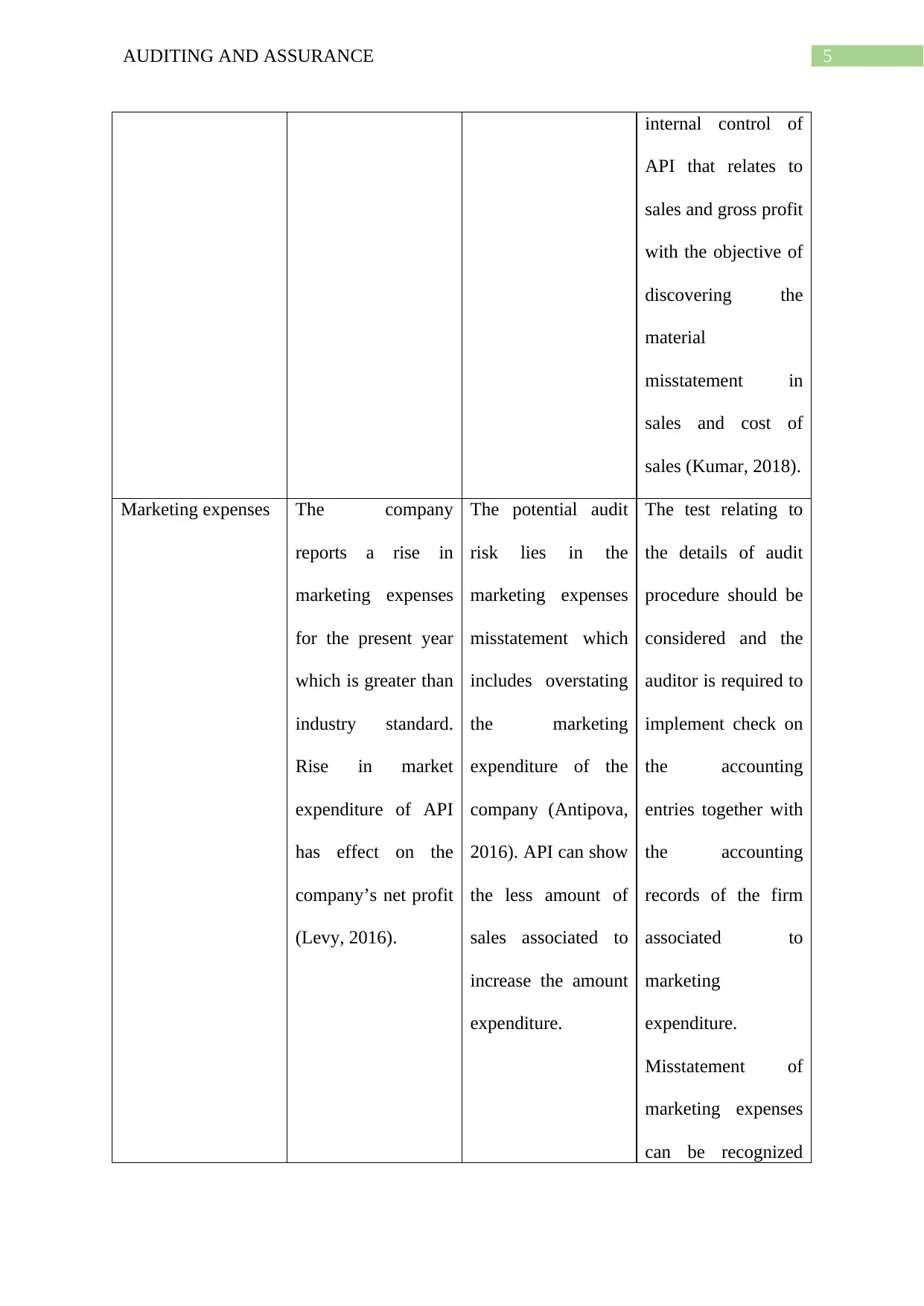
5AUDITING AND ASSURANCE
internal control of
API that relates to
sales and gross profit
with the objective of
discovering the
material
misstatement in
sales and cost of
sales (Kumar, 2018).
Marketing expenses The company
reports a rise in
marketing expenses
for the present year
which is greater than
industry standard.
Rise in market
expenditure of API
has effect on the
company’s net profit
(Levy, 2016).
The potential audit
risk lies in the
marketing expenses
misstatement which
includes overstating
the marketing
expenditure of the
company (Antipova,
2016). API can show
the less amount of
sales associated to
increase the amount
expenditure.
The test relating to
the details of audit
procedure should be
considered and the
auditor is required to
implement check on
the accounting
entries together with
the accounting
records of the firm
associated to
marketing
expenditure.
Misstatement of
marketing expenses
can be recognized
internal control of
API that relates to
sales and gross profit
with the objective of
discovering the
material
misstatement in
sales and cost of
sales (Kumar, 2018).
Marketing expenses The company
reports a rise in
marketing expenses
for the present year
which is greater than
industry standard.
Rise in market
expenditure of API
has effect on the
company’s net profit
(Levy, 2016).
The potential audit
risk lies in the
marketing expenses
misstatement which
includes overstating
the marketing
expenditure of the
company (Antipova,
2016). API can show
the less amount of
sales associated to
increase the amount
expenditure.
The test relating to
the details of audit
procedure should be
considered and the
auditor is required to
implement check on
the accounting
entries together with
the accounting
records of the firm
associated to
marketing
expenditure.
Misstatement of
marketing expenses
can be recognized
⊘ This is a preview!⊘
Do you want full access?
Subscribe today to unlock all pages.

Trusted by 1+ million students worldwide
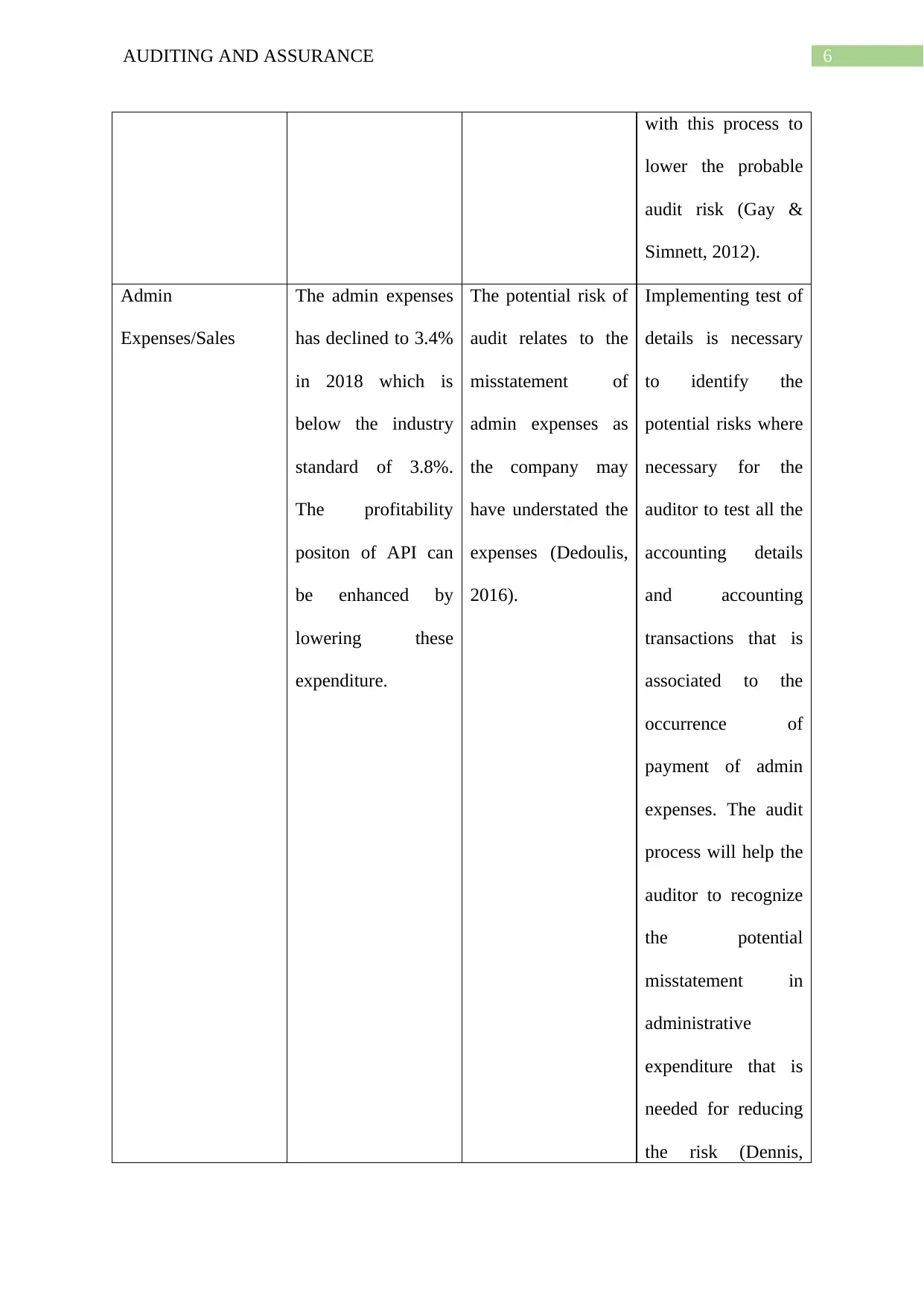
6AUDITING AND ASSURANCE
with this process to
lower the probable
audit risk (Gay &
Simnett, 2012).
Admin
Expenses/Sales
The admin expenses
has declined to 3.4%
in 2018 which is
below the industry
standard of 3.8%.
The profitability
positon of API can
be enhanced by
lowering these
expenditure.
The potential risk of
audit relates to the
misstatement of
admin expenses as
the company may
have understated the
expenses (Dedoulis,
2016).
Implementing test of
details is necessary
to identify the
potential risks where
necessary for the
auditor to test all the
accounting details
and accounting
transactions that is
associated to the
occurrence of
payment of admin
expenses. The audit
process will help the
auditor to recognize
the potential
misstatement in
administrative
expenditure that is
needed for reducing
the risk (Dennis,
with this process to
lower the probable
audit risk (Gay &
Simnett, 2012).
Admin
Expenses/Sales
The admin expenses
has declined to 3.4%
in 2018 which is
below the industry
standard of 3.8%.
The profitability
positon of API can
be enhanced by
lowering these
expenditure.
The potential risk of
audit relates to the
misstatement of
admin expenses as
the company may
have understated the
expenses (Dedoulis,
2016).
Implementing test of
details is necessary
to identify the
potential risks where
necessary for the
auditor to test all the
accounting details
and accounting
transactions that is
associated to the
occurrence of
payment of admin
expenses. The audit
process will help the
auditor to recognize
the potential
misstatement in
administrative
expenditure that is
needed for reducing
the risk (Dennis,
Paraphrase This Document
Need a fresh take? Get an instant paraphrase of this document with our AI Paraphraser
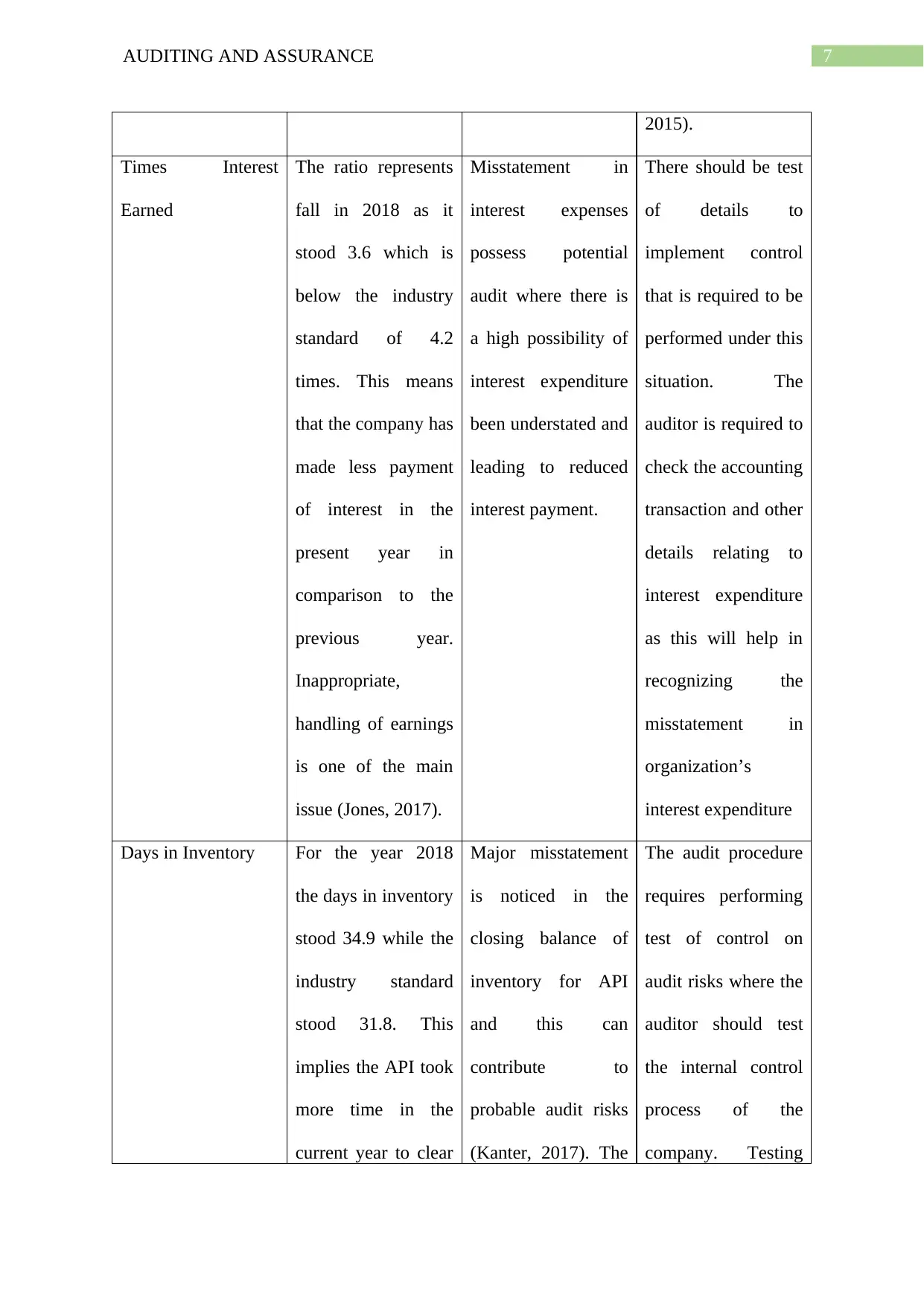
7AUDITING AND ASSURANCE
2015).
Times Interest
Earned
The ratio represents
fall in 2018 as it
stood 3.6 which is
below the industry
standard of 4.2
times. This means
that the company has
made less payment
of interest in the
present year in
comparison to the
previous year.
Inappropriate,
handling of earnings
is one of the main
issue (Jones, 2017).
Misstatement in
interest expenses
possess potential
audit where there is
a high possibility of
interest expenditure
been understated and
leading to reduced
interest payment.
There should be test
of details to
implement control
that is required to be
performed under this
situation. The
auditor is required to
check the accounting
transaction and other
details relating to
interest expenditure
as this will help in
recognizing the
misstatement in
organization’s
interest expenditure
Days in Inventory For the year 2018
the days in inventory
stood 34.9 while the
industry standard
stood 31.8. This
implies the API took
more time in the
current year to clear
Major misstatement
is noticed in the
closing balance of
inventory for API
and this can
contribute to
probable audit risks
(Kanter, 2017). The
The audit procedure
requires performing
test of control on
audit risks where the
auditor should test
the internal control
process of the
company. Testing
2015).
Times Interest
Earned
The ratio represents
fall in 2018 as it
stood 3.6 which is
below the industry
standard of 4.2
times. This means
that the company has
made less payment
of interest in the
present year in
comparison to the
previous year.
Inappropriate,
handling of earnings
is one of the main
issue (Jones, 2017).
Misstatement in
interest expenses
possess potential
audit where there is
a high possibility of
interest expenditure
been understated and
leading to reduced
interest payment.
There should be test
of details to
implement control
that is required to be
performed under this
situation. The
auditor is required to
check the accounting
transaction and other
details relating to
interest expenditure
as this will help in
recognizing the
misstatement in
organization’s
interest expenditure
Days in Inventory For the year 2018
the days in inventory
stood 34.9 while the
industry standard
stood 31.8. This
implies the API took
more time in the
current year to clear
Major misstatement
is noticed in the
closing balance of
inventory for API
and this can
contribute to
probable audit risks
(Kanter, 2017). The
The audit procedure
requires performing
test of control on
audit risks where the
auditor should test
the internal control
process of the
company. Testing
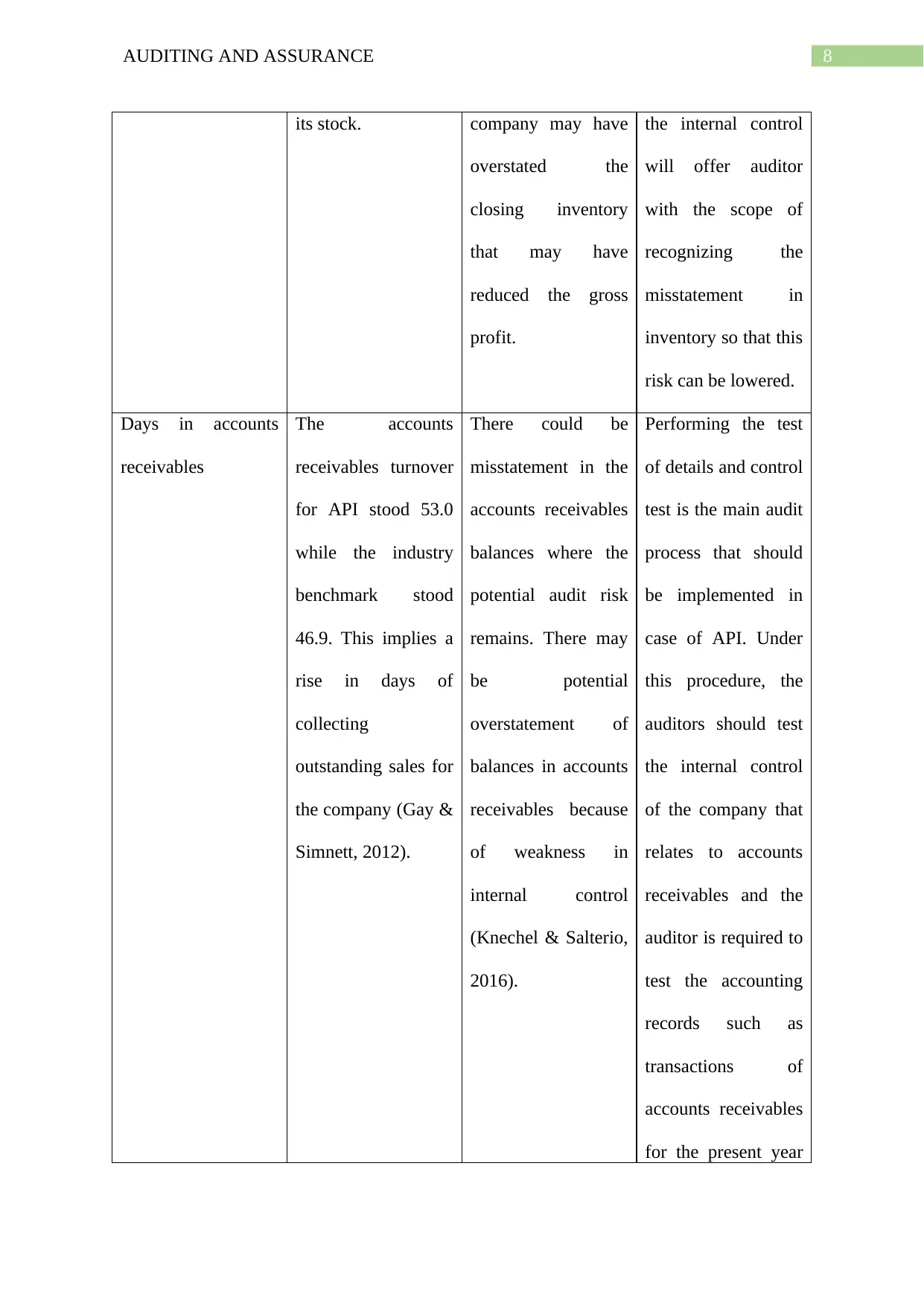
8AUDITING AND ASSURANCE
its stock. company may have
overstated the
closing inventory
that may have
reduced the gross
profit.
the internal control
will offer auditor
with the scope of
recognizing the
misstatement in
inventory so that this
risk can be lowered.
Days in accounts
receivables
The accounts
receivables turnover
for API stood 53.0
while the industry
benchmark stood
46.9. This implies a
rise in days of
collecting
outstanding sales for
the company (Gay &
Simnett, 2012).
There could be
misstatement in the
accounts receivables
balances where the
potential audit risk
remains. There may
be potential
overstatement of
balances in accounts
receivables because
of weakness in
internal control
(Knechel & Salterio,
2016).
Performing the test
of details and control
test is the main audit
process that should
be implemented in
case of API. Under
this procedure, the
auditors should test
the internal control
of the company that
relates to accounts
receivables and the
auditor is required to
test the accounting
records such as
transactions of
accounts receivables
for the present year
its stock. company may have
overstated the
closing inventory
that may have
reduced the gross
profit.
the internal control
will offer auditor
with the scope of
recognizing the
misstatement in
inventory so that this
risk can be lowered.
Days in accounts
receivables
The accounts
receivables turnover
for API stood 53.0
while the industry
benchmark stood
46.9. This implies a
rise in days of
collecting
outstanding sales for
the company (Gay &
Simnett, 2012).
There could be
misstatement in the
accounts receivables
balances where the
potential audit risk
remains. There may
be potential
overstatement of
balances in accounts
receivables because
of weakness in
internal control
(Knechel & Salterio,
2016).
Performing the test
of details and control
test is the main audit
process that should
be implemented in
case of API. Under
this procedure, the
auditors should test
the internal control
of the company that
relates to accounts
receivables and the
auditor is required to
test the accounting
records such as
transactions of
accounts receivables
for the present year
⊘ This is a preview!⊘
Do you want full access?
Subscribe today to unlock all pages.

Trusted by 1+ million students worldwide
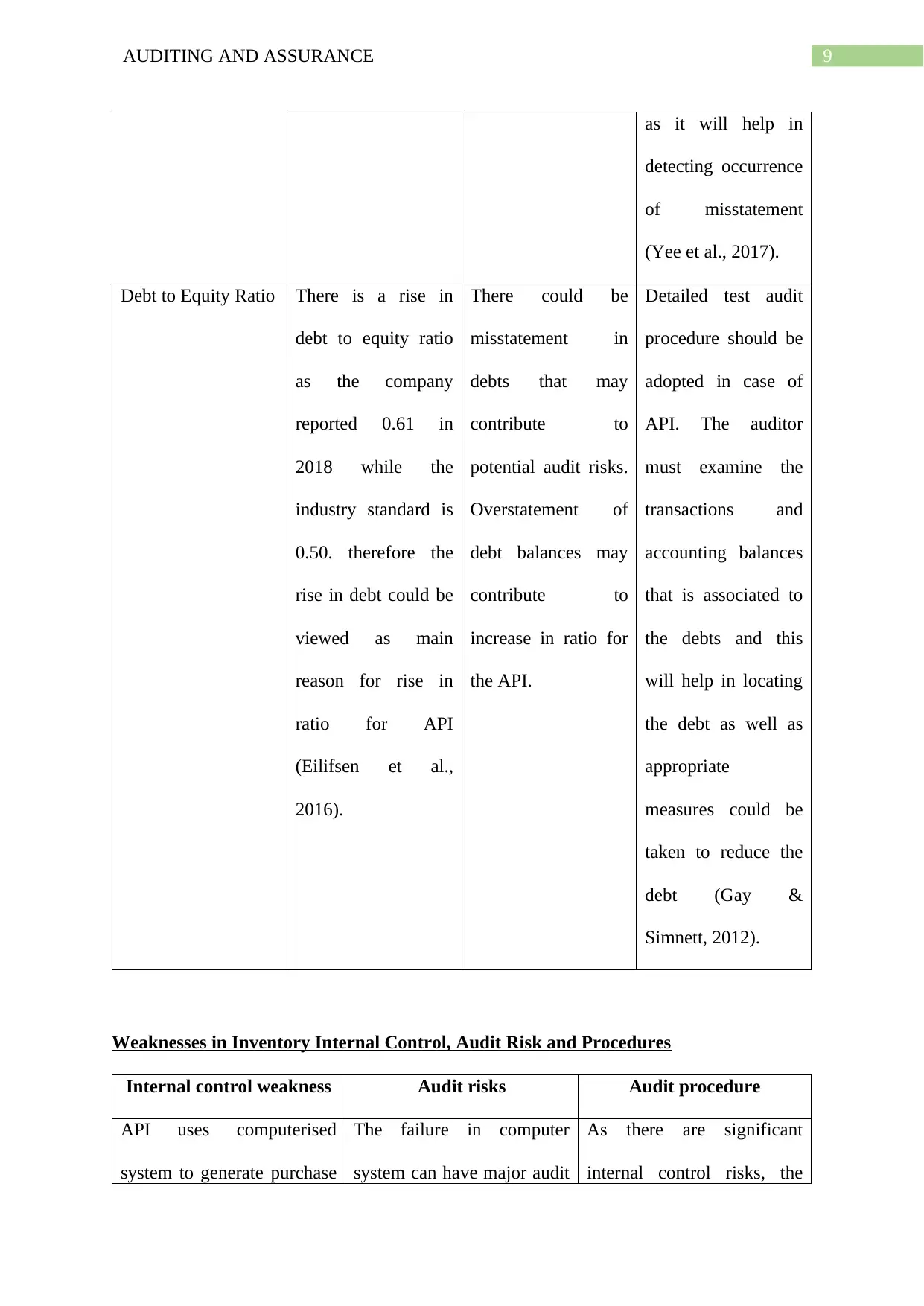
9AUDITING AND ASSURANCE
as it will help in
detecting occurrence
of misstatement
(Yee et al., 2017).
Debt to Equity Ratio There is a rise in
debt to equity ratio
as the company
reported 0.61 in
2018 while the
industry standard is
0.50. therefore the
rise in debt could be
viewed as main
reason for rise in
ratio for API
(Eilifsen et al.,
2016).
There could be
misstatement in
debts that may
contribute to
potential audit risks.
Overstatement of
debt balances may
contribute to
increase in ratio for
the API.
Detailed test audit
procedure should be
adopted in case of
API. The auditor
must examine the
transactions and
accounting balances
that is associated to
the debts and this
will help in locating
the debt as well as
appropriate
measures could be
taken to reduce the
debt (Gay &
Simnett, 2012).
Weaknesses in Inventory Internal Control, Audit Risk and Procedures
Internal control weakness Audit risks Audit procedure
API uses computerised
system to generate purchase
The failure in computer
system can have major audit
As there are significant
internal control risks, the
as it will help in
detecting occurrence
of misstatement
(Yee et al., 2017).
Debt to Equity Ratio There is a rise in
debt to equity ratio
as the company
reported 0.61 in
2018 while the
industry standard is
0.50. therefore the
rise in debt could be
viewed as main
reason for rise in
ratio for API
(Eilifsen et al.,
2016).
There could be
misstatement in
debts that may
contribute to
potential audit risks.
Overstatement of
debt balances may
contribute to
increase in ratio for
the API.
Detailed test audit
procedure should be
adopted in case of
API. The auditor
must examine the
transactions and
accounting balances
that is associated to
the debts and this
will help in locating
the debt as well as
appropriate
measures could be
taken to reduce the
debt (Gay &
Simnett, 2012).
Weaknesses in Inventory Internal Control, Audit Risk and Procedures
Internal control weakness Audit risks Audit procedure
API uses computerised
system to generate purchase
The failure in computer
system can have major audit
As there are significant
internal control risks, the
Paraphrase This Document
Need a fresh take? Get an instant paraphrase of this document with our AI Paraphraser
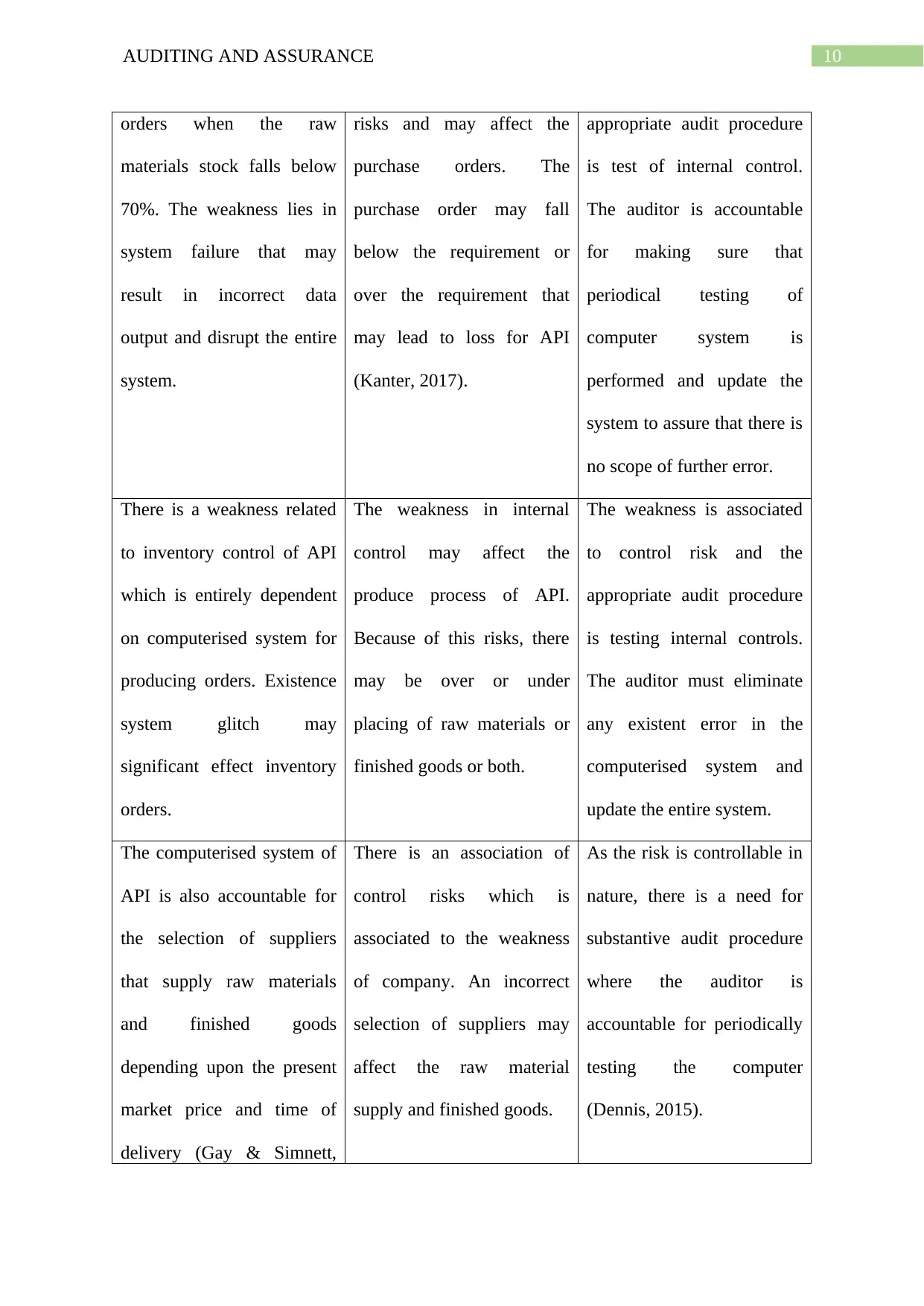
10AUDITING AND ASSURANCE
orders when the raw
materials stock falls below
70%. The weakness lies in
system failure that may
result in incorrect data
output and disrupt the entire
system.
risks and may affect the
purchase orders. The
purchase order may fall
below the requirement or
over the requirement that
may lead to loss for API
(Kanter, 2017).
appropriate audit procedure
is test of internal control.
The auditor is accountable
for making sure that
periodical testing of
computer system is
performed and update the
system to assure that there is
no scope of further error.
There is a weakness related
to inventory control of API
which is entirely dependent
on computerised system for
producing orders. Existence
system glitch may
significant effect inventory
orders.
The weakness in internal
control may affect the
produce process of API.
Because of this risks, there
may be over or under
placing of raw materials or
finished goods or both.
The weakness is associated
to control risk and the
appropriate audit procedure
is testing internal controls.
The auditor must eliminate
any existent error in the
computerised system and
update the entire system.
The computerised system of
API is also accountable for
the selection of suppliers
that supply raw materials
and finished goods
depending upon the present
market price and time of
delivery (Gay & Simnett,
There is an association of
control risks which is
associated to the weakness
of company. An incorrect
selection of suppliers may
affect the raw material
supply and finished goods.
As the risk is controllable in
nature, there is a need for
substantive audit procedure
where the auditor is
accountable for periodically
testing the computer
(Dennis, 2015).
orders when the raw
materials stock falls below
70%. The weakness lies in
system failure that may
result in incorrect data
output and disrupt the entire
system.
risks and may affect the
purchase orders. The
purchase order may fall
below the requirement or
over the requirement that
may lead to loss for API
(Kanter, 2017).
appropriate audit procedure
is test of internal control.
The auditor is accountable
for making sure that
periodical testing of
computer system is
performed and update the
system to assure that there is
no scope of further error.
There is a weakness related
to inventory control of API
which is entirely dependent
on computerised system for
producing orders. Existence
system glitch may
significant effect inventory
orders.
The weakness in internal
control may affect the
produce process of API.
Because of this risks, there
may be over or under
placing of raw materials or
finished goods or both.
The weakness is associated
to control risk and the
appropriate audit procedure
is testing internal controls.
The auditor must eliminate
any existent error in the
computerised system and
update the entire system.
The computerised system of
API is also accountable for
the selection of suppliers
that supply raw materials
and finished goods
depending upon the present
market price and time of
delivery (Gay & Simnett,
There is an association of
control risks which is
associated to the weakness
of company. An incorrect
selection of suppliers may
affect the raw material
supply and finished goods.
As the risk is controllable in
nature, there is a need for
substantive audit procedure
where the auditor is
accountable for periodically
testing the computer
(Dennis, 2015).
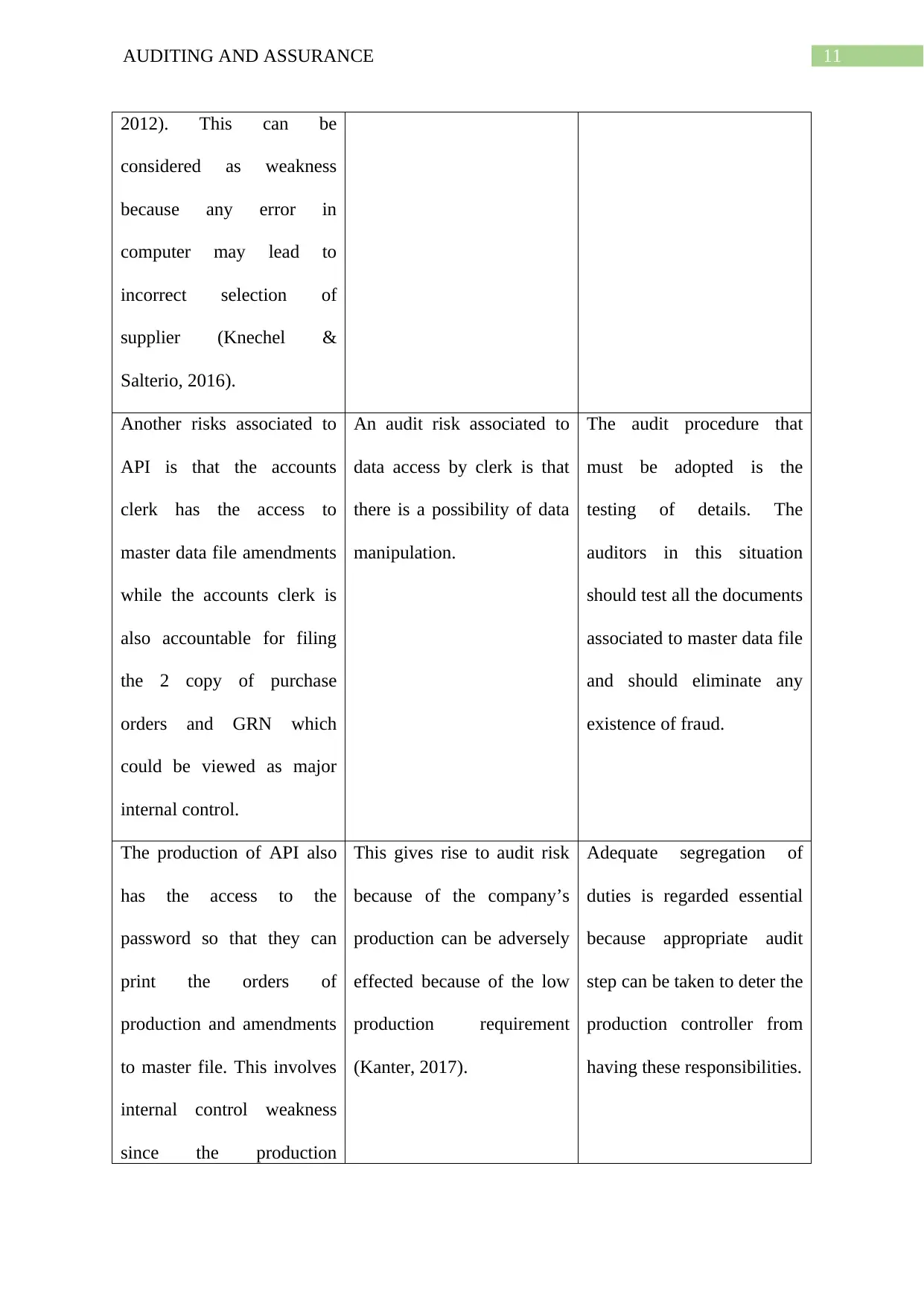
11AUDITING AND ASSURANCE
2012). This can be
considered as weakness
because any error in
computer may lead to
incorrect selection of
supplier (Knechel &
Salterio, 2016).
Another risks associated to
API is that the accounts
clerk has the access to
master data file amendments
while the accounts clerk is
also accountable for filing
the 2 copy of purchase
orders and GRN which
could be viewed as major
internal control.
An audit risk associated to
data access by clerk is that
there is a possibility of data
manipulation.
The audit procedure that
must be adopted is the
testing of details. The
auditors in this situation
should test all the documents
associated to master data file
and should eliminate any
existence of fraud.
The production of API also
has the access to the
password so that they can
print the orders of
production and amendments
to master file. This involves
internal control weakness
since the production
This gives rise to audit risk
because of the company’s
production can be adversely
effected because of the low
production requirement
(Kanter, 2017).
Adequate segregation of
duties is regarded essential
because appropriate audit
step can be taken to deter the
production controller from
having these responsibilities.
2012). This can be
considered as weakness
because any error in
computer may lead to
incorrect selection of
supplier (Knechel &
Salterio, 2016).
Another risks associated to
API is that the accounts
clerk has the access to
master data file amendments
while the accounts clerk is
also accountable for filing
the 2 copy of purchase
orders and GRN which
could be viewed as major
internal control.
An audit risk associated to
data access by clerk is that
there is a possibility of data
manipulation.
The audit procedure that
must be adopted is the
testing of details. The
auditors in this situation
should test all the documents
associated to master data file
and should eliminate any
existence of fraud.
The production of API also
has the access to the
password so that they can
print the orders of
production and amendments
to master file. This involves
internal control weakness
since the production
This gives rise to audit risk
because of the company’s
production can be adversely
effected because of the low
production requirement
(Kanter, 2017).
Adequate segregation of
duties is regarded essential
because appropriate audit
step can be taken to deter the
production controller from
having these responsibilities.
⊘ This is a preview!⊘
Do you want full access?
Subscribe today to unlock all pages.

Trusted by 1+ million students worldwide
1 out of 19
Related Documents
Your All-in-One AI-Powered Toolkit for Academic Success.
+13062052269
info@desklib.com
Available 24*7 on WhatsApp / Email
![[object Object]](/_next/static/media/star-bottom.7253800d.svg)
Unlock your academic potential
Copyright © 2020–2025 A2Z Services. All Rights Reserved. Developed and managed by ZUCOL.





